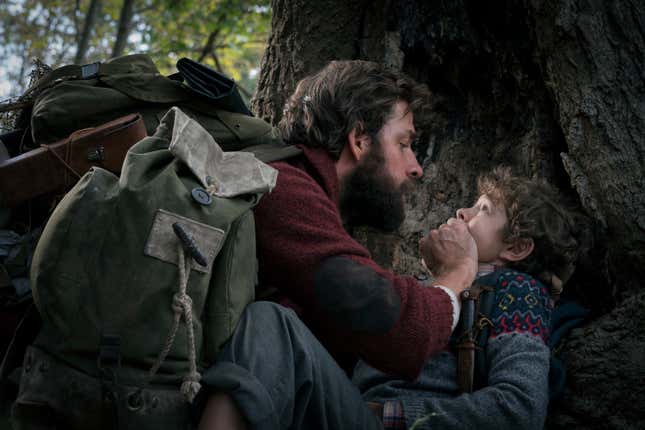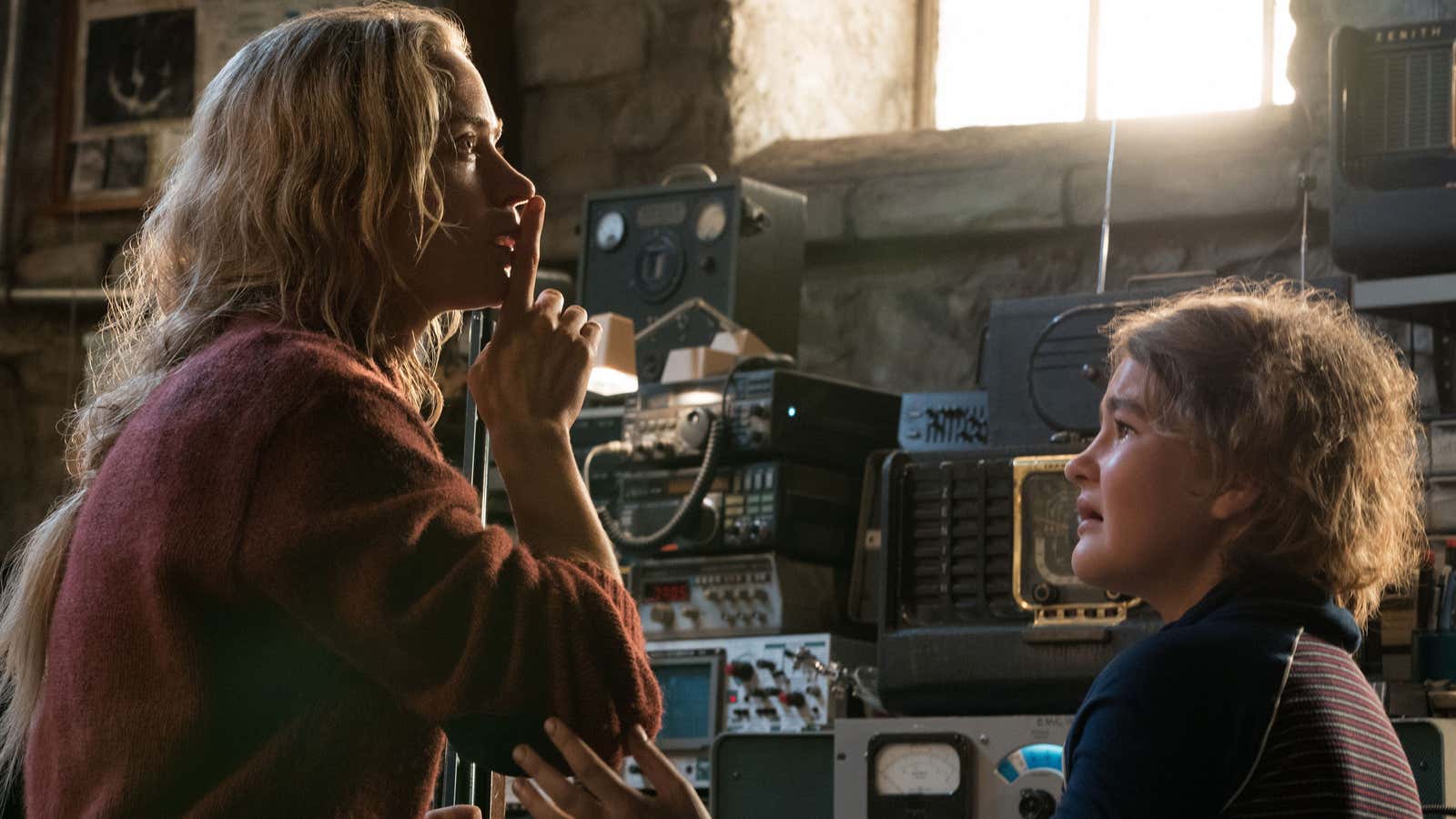At a packed screening of the horror movie A Quiet Place in Manhattan last week, you could have quite literally heard a pin drop. You could hear the person behind you breathing (or trying not to). You could hear the silence.
“That’s the holy grail,” said Erik Aadahl, one of the sound designers responsible for this chillingly sparse sonic tapestry, in an interview with Quartz. For a film where humans must be silent to survive, the goal, he said, was to “make an audience lean in and become afraid themselves to make a sound.”
It worked. A Quiet Place tracks a family of four—John Krasinski of The Office fame (who also directed), Emily Blunt (the duo are married in real life), and two superb young actors named Millicent Simmonds and Noah Jupe—as they try to survive a world that has been invaded by bloodthirsty alien creatures. The catch: These creatures are completely blind but can zero in on any sound—however faint—and attack its source with the savagery and efficiency of a Tomahawk missile.
In a world where making sound gets you devoured, A Quiet Place is, naturally, a quiet film. By the time the film begins (months after the unseen invasion occurs), anything that’s survived has already adapted. The family speaks in sign language and walks barefoot through the environs of their farmhouse over pre-planned paths made of sand. Birds don’t chirp. Even the insects have learned not to call attention to themselves.
“We never put a single cricket [sound] in anywhere, which we would in any other movie which takes place on a rural farm,” Aadahl said. “No roosters have survived this world.”
You may be thinking, what exactly do sound designers do when a film is so quiet? The answer is: a lot. Perhaps even more than in a film that uses sound in normal ways. Aadahl said A Quiet Place was one of the most challenging films he and co-supervising sound editor Ethan Van der Ryn had ever worked on, and they’ve worked on some loud, elaborate ones, including Godzilla and Transformers.
The sparseness of sound in the film means that every time there was a sudden noise, it needed to be organic and effective. Aadahl explained this challenge with an apt painting metaphor.
“In a Rembrandt painting, or a beautiful Caravaggio painting, there’s a shaft of light made more beautiful by the darkness around it—that’s the negative space,” he said. “In a sense, sonically, silence is the negative space. It’s the valley that allows you to appreciate the peak.”
Those peaks are often the otherworldly shrieks, clicks, and gurgles of the alien creatures, whose wide array of ear-splitting sounds punctuate the film’s long stretches of quiet. You hear them before you see them. In most horror films, jump scares are cheaply manufactured by sudden visual cues, like a masked intruder popping up in a window. Those cues are typically accompanied by a gimmicky, non-diegetic (that is, outside the world of the film) sound made to artificially enhance the scare. A Quiet Place doesn’t have those—the alien sounds are the jump scares that conjure such abject terror out of the silence. (While most of the creatures’ sounds are not based on any real animal, the pair said that its “searching” sound, which renders as a creepy clicking, is based on the echolocation ability of dolphins.)
When used sparingly, these sounds are extremely effective. Like the Chiaroscuro technique in art (bold contrasts between dark and light), the sound in A Quiet Place juxtaposes eerie silence with stunning snatches of the alien soundscape. It’s a similar philosophy to that of visually striking shows such as Mr. Robot—contrasting one sensory extreme with another to emphasize both of them.

Initially, Aadahl and Van der Ryn had the aliens vocalizing even more, but they realized that contradicted the creatures’ internal logic. “They actually hate sound, so it wouldn’t make sense that they’d be making a lot of sounds themselves,” Van der Ryn said. And they don’t, except in those devastatingly shocking moments in between the noiselessness.
The sound team’s biggest challenge of all, however, was not extraterrestrial. The daughter in the film, Regan (Simmonds), is deaf, and she uses a variety of makeshift cochlear implants crafted by her father (Krasinski). Simmonds, who is deaf herself, helped Krasinski and the sound designers translate what a deaf person’s experience in this world might be like. They matched the sound of her cochlear implant to Simmonds’ description, and then raised the volume of environmental sounds before and after Regan turned the implant on to create contrast.
When her implant is turned off, Aadahl said, they sucked all sound out of the film like a vacuum, going to absolute, digital zero. Total silence. In one scene, Regan’s implant is turned off at a particularly disturbing moment. As the camera focuses in on Simmonds’ face, the audience can’t hear or see a thing, save for her reaction to what’s unfolding. Simmonds completely sells the performance.
“In any other movie, you’d have a big score going at that moment and scary sounds and everything, but having that juxtaposition of the intensity of her performance and the total silence just gives me goosebumps,” Aadahl said.
A Quiet Place is expected to do well at the box office, helped in no small part to great word of mouth and a dominant 97% critics score on Rotten Tomatoes.
Aadahl and Van der Ryn joke that they’d like for there to be a sequel called “A Quieter Place.” If the first film performs as well as expected, they might just get their wish. But is there anything quieter—or scarier—than silence?
